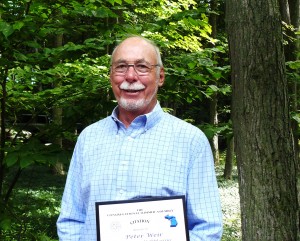
All congregations rely on those who share their time and talents for the benefit of the community as a whole. Each summer we on the Citations Committee get to recognize the extraordinary volunteer service of one among the many who make the Congregational Summer Assembly the place that it is. Every year most of us leave the grounds at the end of our time here paying attention only to closing our own cottages. When we return in the spring or summer one often-heard expression is “It looks as if the waterfront and beach just got rolled up like a huge carpet at the end of August and unrolled again for the start of a new season.” Everything is just where it was last year and the year before and the year before that – and you probably don’t spend a lot of time thinking about how this happens – except perhaps this July when people asked “Where’s the slide?”. Our common areas are preserved and improved by the tireless efforts and skills of individuals whose work is so often done far from center stage that their contributions can be overlooked or taken for granted. Today we recognize with the Citation for Long and Valued Service to the Assembly someone who fits that description completely – Peter “Pete” Weir.
Pete’s grandmother, Mabel Penfield Wilson, first came here in 1906 and the family has been a mainstay of Wildwood since the mid-40’s. As it was for many other families from St. Louis, Pilgrim was a cool and inviting destination during the hot summer months. Pete, his sister Joan and brother Tom were here all summer as children and, like so many of us, Pete found jobs during high school and college summers so he could be here and not ‘there.” He started by delivering phone messages and telegrams for the CSA office during those years before individual cottages had telephones (let alone cell phones and internet service), he worked at Bill Olsen’s Assembly gas station, and he worked at the canning factory in town – with no car, that meant bicycling in and back every day. Pete went to college at Cornell and the University of Missouri, graduating with a degree in mechanical engineering. Unbeknownst to him, Nancy Kinter, who grew up on the adjoining property to the Weirs in St. Louis, came to the CSA with her family from the ages of 10 to14, staying in the Lodge. After college Pete discovered “the girl next door” and, while they were dating, he talked about having her visit this “funky” little place where his family had a cottage. I don’t need to tell you the rest of that story.
Pete’s work as a refrigeration engineer took them to Minneapolis to live and he was able to develop and indulge his passion for sailing and all things connected with water. A championship sailor, he also loved to restore old boats – on Lake Minnetonka in Minneapolis he was part of a group that rebuilt boats that had sunk in the lake and he took a leading role in the restoration of a 1906 steam boat, the Minnehaha, that had been sunk in 1926. Joel Buzzell says “Give him a weatherbeaten board and he’ll build a boat around it!” Family and friends think of him as the original “McGyver” – he can solve everything mechanical and probably has more tools than McGyver ever had on the TV show. But there are those in his family who say the least he could do is raise something useful from the bottom of Crystal Lake and restore it!
He was always a good problem solver, taking things apart and putting them back together to see how they worked. After one project undertaken in high school we can be glad he decided to get some professional education in the field before he got his hands on CSA facilities. He and some friends decided to build a swimming pool at the house in St. Louis. They put up wooden forms and when it came time to pour the concrete the forms fell into the bottom of the pool. It took a pick axe to break up the concrete and the bottom of the pool always had idiosyncracies.
Two years before he retired, Pete and Nancy tested out what it would be like to spend more than a two week’s vacation here so he worked from the cottage and started his volunteer activities here in earnest by becoming involved with the Waterfront and Buildings and Grounds committees. One reason the waterfront looks as it should every year is that Pete takes out the boat moorings each fall and puts them back in place in the spring. He waits until the last fall swimmers call it a season, then takes in the lifeline, carefully coiling it and organizing it for storage in the doghouse. In the spring, after McDonald puts in the boat dock Pete checks it out and he has repaired it with new hardware.
When Pilgrim Place was nearly destroyed in that devastating fire last year the many volunteers who helped with the clean up and restoration have told me that it was Pete who took the lead on the project, calling on his many areas of expertise and giving hours and hours of labor. He says he likes to see things done right and through his time and talents that project was done right.
Likewise – if you look at the bell tower here on the Meeting House you wouldn’t notice anything different about it. But last fall they discovered it was rotting away so it was taken down and put in the Buzzells’ back yard. It was Pete who figured out how to rebuild it so that the finished bell tower looks the same to us but is actually far better than new.
When all creative and urban-legend-driven efforts to keep seagulls away from the rafts and lifeguard stands failed, Pete designed the ungainly but totally effective pole-and-fishing line apparatus that has made the rafts a desirable swimming destination again.
The “Yield to Uphillers” sign at the Michigan end of Alden-Edwards Avenue? A Pete Weir creation. And he has devoted hours of volunteer time to the Point Betsie restoration project as well.
I am told that he can build anything and that he can fix anything – but here is fair warning – don’t ask him to do anything with a computer! He not only can’t fix them – he seemingly can’t help disabling them!
So, Pete, we won’t ask you to fix the office computer – but we are happy to be able to “bring your light out from under the bushel” and let everyone know how much of what we take for granted is the result of your quiet efforts. I’m delighted to present this Citation to you. Your name has been engraved on the Citation Plaque at the back of the Meeting House and I know that everyone looks forward to thanking you personally after the service.
